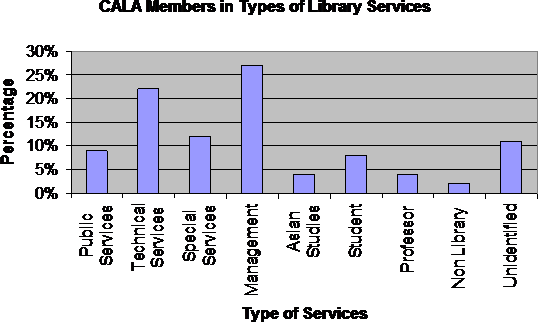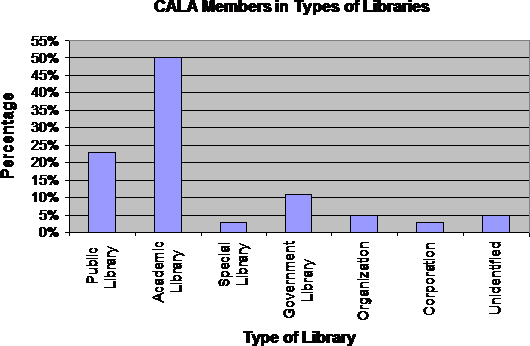
Fig. 1. CALA Member in Types of Library Services
The Chinese American Librarians Association (CALA) has triumphed its first thirty years. It deserves a special commemoration. CALA is a treasure we have inherited from our pioneers. It is a tie to assemble our strengths and a channel to voice our concerns. I have been honored to serve as the chair of CALA Membership Committee for two terms (2001/02 and 2002/03). In this article, I will use the data of CALA membership to show the status changes of our membership in the past 30 years.
In 1973 when CALA just started, there were 18 members. At that time, according to Dr. Tze-chung Li, about 1,000 Chinese American librarians worked in the profession in U.S.[1] In her article “The History and Status of Chinese Americans in Librarianship”[2], Dr. Mengxiong Liu acknowledged that “Unfortunately, the U.S. census no longer provided a detailed breakdown data by occupation for Asian American groups in 1990. The total number of Asian/Pacific American librarians was recorded as 6,776.” From this data, we can reasonably estimate that in about 20 years from 1973 to 1990, the number of Chinese American librarians increased at most no more than six times (i.e., from one thousand to six thousand). Today, in CALA's membership database, we have a total of 970 registered names. Among them, 570 are current members. The number of our members, compared with that of 30 years ago when CALA started, has increased over 30 times.
The ratio of CALA members and Chinese American librarians in the U.S. are about 1:56 in 1973 and 1:11 (at the most) in 1990. This also demonstrates the increasing strength of CALA.
Moreover, Chinese American librarians’ status has undergone an essential change. Here, I would like to quote a story that Dr. Eugene Wu, has told me:
"I was working as a student assistant in the University of Washington Libraries when I was an undergraduate at UW in the late 1940s. Because of my work there I became interested in library service as a career. At the time I had a very caring and kind supervisor who was the head of what was known as the Acquisition Department (now Collection Development). When I told her that I was going to enroll in UW's School of Librarianship after I finished my undergraduate work, she became quite concerned and asked whether I was sure I wanted to do that because she said: ‘I'm afraid we won't have a job for you here after you graduate.’ That kind of statement may sound unacceptable nowadays because I am Chinese. But I knew better. I knew she was sincere and was truly concerned about my being able to find a job as a professional librarian, for there were in those days practically no Chinese professional librarians anywhere in the US. She honestly didn't think I could find a professional job as a librarian, and I wasn't sure myself. In any case, I did enroll in UW's library school and became the very first Chinese student in the school's history."[3]Dr. Eugene Wu began his life-long library career at Stanford University's Hoover Institution (1951-1965) and then at Harvard University 's Harvard-Yenching Library (1965-1997). “For four decades, Dr. Wu was the dynamic leading force in the development of research sources for modern and contemporary China studies. Under his able leadership, the collections in both libraries have since become the most distinguished East Asian research collections in the world.”[4]
The current CALA members have been surveyed at the end of March 2003. Of the near six-hundred current members, nine percent (9%) of CALA members are working in the Public Services; twenty-two percent (22%) are in Technical services; twelve percent (12%) are special librarians (e.g., archivists, American culture librarians, and children librarians); twenty-seven percent (27%) working at the management level (e.g., branch managers, directors of a department, and heads of a library); eight percent (8%) are students in schools of library and information science; twelve percent (12%) are unidentified since the entry under the “Job Title” is “librarian”; four percent (4%) in Asian studies; two percent (2%) are working in non-library fields (e.g., managers in a book store); and four percent (4%) having “professor” titles. (See Fig. 1)

Twenty-three percent (23%) of the current CALA members are working in the public libraries, fifty percent (50%) in academic libraries or education institutions; eleven percent (11%) working in governmental libraries (e.g., Library of Congress, and military libraries); five percent (5%) in library-related organizations (e.g., OCLC); three percent (3%) in corporations; five percent (5%) are unidentified since most are retired and have no work institution input; three percent (3%) are in special libraries. (See Fig. 2)

In conclusion, Chinese American librarians are now working in almost every library-related professional field and in all types of libraries. As Dr. Eugene Wu has said, “Today is totally different. It's no longer a question whether Chinese Americans can find employment. It's rather in what ways can they better contribute to the advancement of the library profession. That's quite a difference between now and then.”[5]
Notes:
[1] Li, Tze-chung. (1983). "10th Year of CALA." Library Association of China Bulletin.
[2] Liu, Mengxiong. (2000). "The History and Status of Chinese Americans in Librarianship." Library Trends, 49(1). 110.
[3] Wu, Eugene. (2001). Speech delivered at the CALA 2001 Award Reception in San Francisco, June 17, 2001; emailed to Lisa Zhao on April 1, 2003.
[4] Liu, Mengxiong. (2000). "The History and Status of Chinese Americans in Librarianship." Library Trends, 49(1). 116
[5] Wu, Eugene. (2001). ibid.